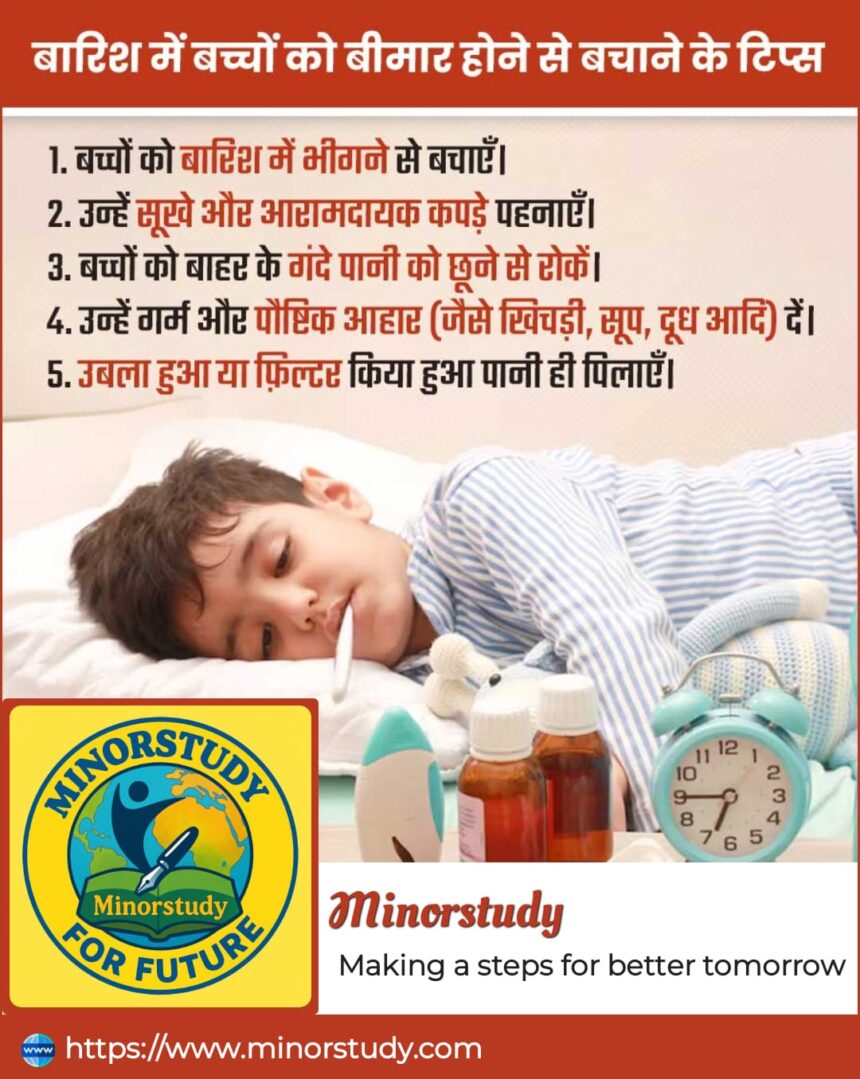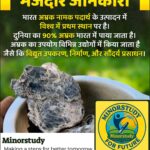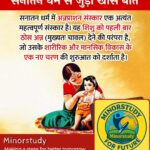🌧️ Vital Monsoon Health Tips to Protect Your Kids from Common Illnesses
Monsoon is a time of joy, freshness, and nature’s symphony. Children love the rain — the puddles, the cool breeze, and the freedom it brings from scorching summers. However, this magical season also brings along an increased risk of infections and diseases, especially in kids whose immune systems are still developing.
- 🏥 Why Are Children More Vulnerable During Monsoon?
- 📜 A Brief History of Monsoon & Health Concerns
- ⏳ Timeline: Monsoon Precautionary Measures
- ✅ 7 Powerful Tips to Keep Children Safe from Illnesses During Monsoon
- 🌂 1. बच्चों को बारिश में भीगने से बचाएँ (Avoid Rain Exposure)
- 👚 2. आरामदायक और सूखे कपड़े पहनाएँ (Dress Comfortably & Dry)
- 🚱 3. बाहर के गंदे पानी को छूने से रोकें (Avoid Dirty Puddles)
- 🍲 4. गर्म और पौष्टिक आहार दें (Give Warm & Nutritious Food)
- 💧 5. उबला हुआ या फ़िल्टर किया हुआ पानी पिलाएँ (Use Boiled or Filtered Water Only)
- 🦟 6. मच्छरों से बचाव करें (Protect from Mosquitoes)
- 🧼 7. स्वच्छता और व्यक्तिगत साफ़-सफ़ाई पर ज़ोर दें (Emphasize Hygiene & Cleanliness)
- 🧠 Frequently Asked Questions (FAQs)
- ❓What are the most common monsoon illnesses in children?
- ❓Can my child eat fruits during monsoon?
- ❓Should kids go outside to play during rain?
- ❓Is AC or fan safe during monsoon for kids?
- 🪔 Significance in Daily Life
- 🎉 Wishing Lines for Parents & Families
- 🧩 Why It’s Important for Society
- 🏁 Conclusion: Let the Rain Nourish, Not Harm
As parents and caregivers, it’s crucial to ensure that children enjoy the rain without falling sick. In this comprehensive article, we explore history, health science, practical tips, FAQs, timeline of precautions, and human-friendly guidance to protect kids during monsoon.
Let’s understand how a rainy season can turn risky for your little ones — and how simple precautions can help them stay safe, healthy, and happy.
🏥 Why Are Children More Vulnerable During Monsoon?
During the rainy season, moisture, stagnant water, and humidity create a breeding ground for bacteria, viruses, and mosquitoes. Kids are naturally active, playful, and often unaware of hygiene — making them more prone to:
Common colds and flu
Waterborne diseases like typhoid and diarrhea
Mosquito-borne diseases like dengue and malaria
Skin infections due to wet clothes and dirty puddles
📜 A Brief History of Monsoon & Health Concerns
The connection between monsoon and health dates back centuries:
In Ayurveda, monsoon is called the Varsha Ritu, a time when the digestive fire is weakened and the body is vulnerable.
Traditional Indian households used herbal decoctions, steamed foods, and seasonal fasts to protect health.
Over time, with urbanization and pollution, rainwater carries more pathogens, increasing the risk of infection, especially among children.
⏳ Timeline: Monsoon Precautionary Measures
| Monsoon Phase | What to Watch For | Key Actions |
|---|---|---|
| Early Monsoon | Sudden weather change, stagnant water | Immunity-boosting diet, keep dry clothes ready |
| Peak Monsoon | Heavy rain, waterlogging, humidity | Avoid wet shoes/clothes, use mosquito repellents |
| Late Monsoon | Damp weather, fungal risks | Clean surroundings, monitor food/water hygiene |
✅ 7 Powerful Tips to Keep Children Safe from Illnesses During Monsoon
🌂 1. बच्चों को बारिश में भीगने से बचाएँ (Avoid Rain Exposure)
Wet clothes and cold weather can lead to hypothermia, cold, and flu.
What to do:
Keep an umbrella or raincoat handy
Change wet clothes immediately
Dry hair and feet thoroughly after any exposure
👚 2. आरामदायक और सूखे कपड़े पहनाएँ (Dress Comfortably & Dry)
Wet or tight clothes cause skin rashes, fungal infections, and discomfort.
What to do:
Use cotton clothes that dry quickly
Prefer full-sleeve shirts and pants to avoid mosquito bites
Always keep an extra set of dry clothes in school bags
🚱 3. बाहर के गंदे पानी को छूने से रोकें (Avoid Dirty Puddles)
Rainwater in cities is often mixed with sewage and industrial waste.
What to do:
Educate children about not jumping in puddles
Keep them away from waterlogged streets
Wash hands and feet thoroughly after outdoor play
🍲 4. गर्म और पौष्टिक आहार दें (Give Warm & Nutritious Food)
During monsoon, digestion slows down. Immunity can dip without proper nutrition.
Best foods:
Moong dal khichdi, vegetable soup, haldi milk
Seasonal fruits like apples, papaya, bananas
Include herbs like tulsi, ginger, ajwain to improve digestion
Avoid:
Oily and fried street foods
Raw leafy vegetables from outside sources
Cold drinks and ice creams
💧 5. उबला हुआ या फ़िल्टर किया हुआ पानी पिलाएँ (Use Boiled or Filtered Water Only)
Most monsoon infections are waterborne. Kids are especially vulnerable.
What to do:
Ensure they drink only boiled or RO water
Clean water bottles daily
Avoid giving them juices or golgappas from roadside vendors
🦟 6. मच्छरों से बचाव करें (Protect from Mosquitoes)
Dengue, chikungunya, and malaria peak during this season.
What to do:
Use mosquito nets, coils, or liquid vaporizers at home
Apply herbal mosquito repellents on kids’ exposed skin
Ensure no stagnant water in pots, tires, buckets around your home
🧼 7. स्वच्छता और व्यक्तिगत साफ़-सफ़ाई पर ज़ोर दें (Emphasize Hygiene & Cleanliness)
Basic hygiene is the strongest shield against infections.
What to do:
Teach kids to wash hands before eating and after coming from outside
Clip nails regularly
Sanitize toys and school items periodically
🧠 Frequently Asked Questions (FAQs)
❓What are the most common monsoon illnesses in children?
Flu, cold, cough, throat infection
Typhoid, cholera, diarrhea
Dengue, malaria, viral fever
Skin infections and fungal rash
❓Can my child eat fruits during monsoon?
Yes, but only washed and fresh seasonal fruits. Avoid pre-cut or street-sold ones.
❓Should kids go outside to play during rain?
Avoid rainy or waterlogged areas. Let them play indoors or in covered areas.
❓Is AC or fan safe during monsoon for kids?
Yes, but avoid direct blasts of cold air and ensure humidity levels are balanced.
🪔 Significance in Daily Life
The care we take during monsoon isn’t just about preventing illness — it’s about teaching children the importance of:
Seasonal awareness
Personal hygiene
Mindful eating
Environmental cleanliness
🎉 Wishing Lines for Parents & Families
🌈 “May this monsoon bring your family wellness, warmth, and wonderful memories — stay safe and enjoy the showers!”
☔ “Let the rainwater fall, but not your child’s immunity — take care and spread awareness.”
🧡 “A little care brings a lot of comfort — happy and healthy monsoon to your kids!”
🧩 Why It’s Important for Society
Creates a healthier generation
Reduces burden on hospitals during disease-prone seasons
Helps spread public health awareness
Empowers rural and urban parents with simple yet powerful knowledge
🏁 Conclusion: Let the Rain Nourish, Not Harm
The monsoon season brings immense beauty, greenery, and freshness — but it also brings hidden risks. Children are the future, and their health must be protected with love, awareness, and simple daily practices.
By following these 7 essential tips, families can ensure their children stay safe, strong, and smiling — even when it’s raining outside.
“This monsoon, let your kids enjoy the rain — but with wisdom, wellness, and warmth.”









I just like the helpful info you provide to your articles. I will bookmark your blog and test once more here regularly. I’m fairly sure I’ll be informed many new stuff right right here! Best of luck for the following!